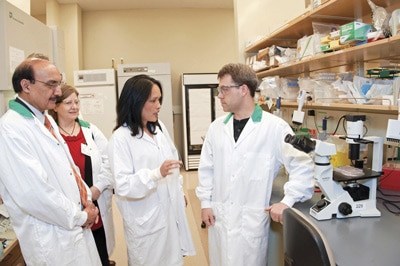Understanding Research
Behind the Scenes with Amgen

© Amgen
While the GI Society’s major focus is on awareness, knowledge transfer, and patient advocacy, our sister charity, the Canadian Society of Intestinal Research, has supported research projects with more than a million dollars. A major fundraising event, such as a walk-a-thon, golf marathon, or gala, might raise many thousands of dollars, but it can feel like just a drop in the research bucket. So why is medical research so expensive?
It’s important to consider the steps – and the costs – between an innovative idea and actually bringing a game-changing medication or therapy to the patients who will benefit from it. In total, it takes about 10-15 years of processes and $1 billion for a single innovation to reach the pharmacy shelf!
Along with a handful of other selected professionals in the health field and some BC politicians, I recently had the fortune of touring the Amgen research centre in Burnaby, BC. My colleagues and I entered the Amgen facility and went right into its core, donning lab coats and protective glasses just as the laboratory’s scientists do every day. We had a peek into the machines, processes, and infrastructure of this busy, custom-built, state-of-the-art, lab. This particular Amgen facility (Amgen research centres are located all over the world) specializes in the discovery and development of human therapeutic antibodies. Physicians use this type of medication for the treatment of cancer, kidney disease, rheumatoid arthritis, bone disease, and other serious illnesses. Tens of thousands of Canadians use Amgen medicines every year. (Amgen does not have products in our therapeutic area and we do not receive funding from them; we’re providing this article for general interest, as other companies manufacture biologic medications in similar ways that target inflammatory bowel disease.)
Researchers sometimes discover innovative therapies while they are studying a condition that is different but related, or they work with specific therapeutic goals in mind, performing numerous experiments until they come up with a novel treatment for a specific ailment. From there, the company completes years of testing and fine-tuning through various clinical trials. At any point along the progression, a great idea might not pan out and the inventors have to start over from scratch, after spending millions of investment dollars. Even failures are an important part of the process. A medicine that might not work for one illness could prove useful in another, and it usually advances scientific understanding of the nature of a disease or how a specific medication works, contributing to future innovations.

© Amgen
More than 75 research scientists, support staff, and field reps work from this centre. Like other pharmaceutical developers, Amgen works toward expanding our understanding of the underlying causes of disease, while advancing potential new therapeutics. They conduct significant numbers of clinical trials within leading academic research institutions, hospitals, and clinics throughout Canada. Approximately 2,000 Canadian patients are currently enrolled in more than 60 Amgen trials across the country.
Once a medicine has passed through all of the necessary clinical trials, the pharmaceutical company must prove to government bodies, through their research evidence, that the medication is safe and needed by patients. Once approved, a company has maybe eight or ten years of market exclusivity before a generic company has the legal right to copy and profit from a medicine considered medically equivalent to the one that the pharmaceutical company spent millions of dollars developing. In the case of biologics, there is no such thing as a ‘generic’ because, for these medications, the manufacturing process is too complex to accurately duplicate. If you would like to know more on this topic, you can read our article about subsequent entry biologics.
There could still be delays before the medication gets to patients who need it, as each provincial, territorial, and several federal jurisdictions (publically-funded plans) all take time to review the medication’s cost-benefit profile before listing it on the public formulary. Private drug plans also take time to determine whether they will cover a medication. This delays patient access to a medication and shortens the company’s patent protection time, during which it will try to re-coup the millions invested in the discovery process.
In addition to simply developing medicines, Amgen also focuses on attracting bright young minds into the field of science by helping educators instruct more effectively and improving access to science resources for teachers, students, and the community. It provides opportunities for aspiring students to gain work experience through active participation in cooperative education programs and other science education and mentoring programs. Many of Amgen’s proprietary research innovations were invented or developed in BC – a testament to the tremendous scientific talent pool that has trained, and continues to work, in that province.Amgen performs exciting scientific research into biologic medicines, which have the potential to revolutionize the ways we fight disease and promote health. It also works in partnership with many of Canada’s leading health care, academic, research, government, and patient organizations to improve the health and well-being of patients dealing with serious illnesses.

